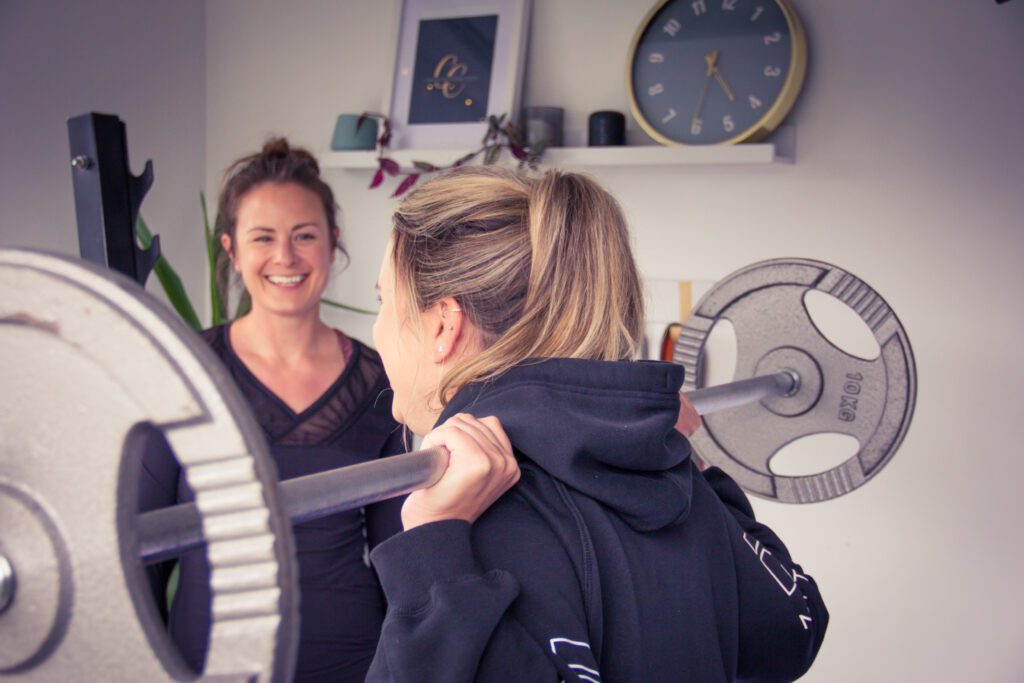Table of Contents
Why Should You Strength Train?
If you’re already juggling a demanding schedule like balancing your career or business, managing clients or teams, running a household, and maybe even caring for others, the idea of adding “one more thing” to your to-do list can feel impossible.
So why, out of all the things you could focus on, should strength training be a priority?
The truth is, looking after your health doesn’t have to mean spending hours on cardio machines, cutting out every food you enjoy, or endlessly adding more to your plate. In fact, sometimes the best results come from doing less, but doing it better.
Strength training is one of those “better” options. Not because it’s the latest fitness trend. Not because it replaces every other type of exercise. But because it makes the rest of life feel easier.
When you build strength, you’re not just training your muscles, you’re supporting every system in your body. Strength training can help:
- Boost your daily energy so you can handle work, family, and life demands without feeling drained
- Protect your joints and improve mobility, making everyday movements easier and safer
- Strengthen your bones, reducing the risk of osteoporosis and injury as you age
- Support a healthy metabolism, making it easier to maintain a stable weight
- Improve confidence and self-belief, helping you feel capable in and out of the gym
- Build resilience so you can keep showing up for the people and commitments that matter to you
It’s not the only tool for better health, but it’s one of the most powerful.
Now, before you think “Strength training isn’t for me” or “I’ll bulk up” or “I’m too old to start,” let’s break down some of the most common myths about strength training and why they’re holding people back from experiencing its benefits.

Myths About Strength Training
If lifting weights feels unfamiliar or like something reserved for younger, fitter, or more “hardcore” people, you’re not alone. Let’s clear up a few common misconceptions:
Does Strength Training Make You Bulky?
No. Building large amounts of muscle requires highly specific training and eating, and even then, it takes years. What you will gain is muscular definition, better posture, and the ability to move through life with more ease.
Is Strength Training Only For Young People?
Absolutely not. Strength training benefits people of all ages — in fact, it becomes even more important as you get older, and it’s never too late to start.
From around age 30, adults naturally lose muscle mass and strength in a process called sarcopenia. Without resistance training, this decline accelerates, impacting balance, bone density, metabolism, and overall independence. The good news is, research shows that strength training can slow, stop, or even reverse muscle loss.
Older adults who lift weights or use resistance bands see improvements in muscle mass, bone strength, mobility, and even cognitive function. It’s never too late to start, and the sooner you begin, the more long-term protection you give your body.
Should I Avoid Strength Training If I Have Joint Pain?
Not necessarily, in fact, the right kind of strength training can help reduce joint pain over time.
Contrary to the myth, strength training doesn’t “wear out” your joints — it strengthens the muscles, tendons, and ligaments that support them.
The key is proper technique, progressive loading, and sometimes modifying exercises to reduce stress on affected joints. Working with a qualified trainer or physiotherapist ensures you strengthen your body safely without aggravating symptoms.
Is Strength Training Risky-Will I Get Injured?
Any physical activity carries some risk, but strength training is actually one of the safest forms of exercise when done with proper technique, gradual progression, and appropriate load. Most strength training injuries happen when people lift too much weight too soon, use poor form, or skip warm-ups. By starting light, focusing on good technique, and following a progressive plan, you can dramatically reduce the chance of injury.
Even better, strength training helps prevent injuries by strengthening muscles, bones, tendons, and ligaments, as well as improving balance and stability. Over time, these adaptations protect your joints and make everyday movements safer.
With the right approach, strength training builds resilience, not risk.
Why Strength Training Matters MORE As You Get Older
You don’t need to become a gym rat or chase personal records. What you do need is the strength to carry your groceries, pick up your kids, walk uphill without effort, and stay active and independent for years to come.
Here’s how strength training supports that:
✅ Protects your bones & joints
Strength training places controlled mechanical load on bone and the surrounding soft tissues, which signals bone-building cells to maintain or increase bone mineral density. This is especially important as estrogen declines in perimenopause/menopause.
✅ Supports your metabolism
We naturally lose muscle over time, and with that loss often comes slower energy, less strength, and weight that feels harder to shift. Strength training helps maintain and rebuild that muscle, keeping your metabolism steady and strong.
✅ Improves posture & reduces common aches
Strength balances your body. It strengthens muscles that support your spine and pelvis, reducing pain and stiffness from sitting, working, or parenting.
✅ Boosts confidence and energy
There’s something deeply empowering about feeling strong in your own body. Whether it’s lifting your suitcase into the overhead bin or simply feeling more grounded, strength shows up in ways that go beyond physical.
✅ Supports hormonal health
Regular strength training can improve insulin sensitivity, sleep, and mood — all of which are impacted by the hormonal shifts of perimenopause and beyond.

How to Start Strength Training
You don’t need to overhaul your life or spend hours in the gym to benefit from strength training. What matters most is having a simple, realistic plan that fits into your week and supports your lifestyle.
🔹 Start with 2–3 short sessions per week
Research shows that even two 30-minute sessions of strength training per week can deliver measurable improvements in muscle tone, strength, and functional fitness — especially for beginners. Scheduling shorter, focused workouts makes it easier to stay consistent, and consistency is where the real results come from.
🔹 Focus on the basics
Prioritise compound movements like squats, lunges, rows, and presses. These exercises work multiple muscle groups at once, improve coordination, and carry over into everyday activities — think lifting groceries, climbing stairs, or carrying a suitcase. For beginners, mastering these fundamental patterns is far more effective than chasing a complicated routine.
🔹 Use what you have
You don’t need a full home gym to start strength training. Your bodyweight is a powerful resistance tool, and inexpensive equipment like dumbbells, kettlebells, or resistance bands can add variety and challenge. The best tool is the one you’ll actually use — so start with what’s accessible and build from there.
🔹 Build gradually
Jumping into high weights or intense routines on Day One is a recipe for frustration (and potential injury). Instead, aim to progress gradually — adding a little more resistance, a few more reps, or an extra set every couple of weeks. This approach strengthens muscles, tendons, and joints at a sustainable pace, reducing the risk of setbacks and keeping your motivation high.

Common Mistakes to Avoid When Beginning Strength Training
1. Skipping the Warm-Up
Jumping straight into heavy lifting without preparing your muscles and joints is just asking for trouble. A good warm-up increases blood flow, improves mobility, and primes your nervous system so you can lift more effectively. Even 5–10 minutes of dynamic movement (like bodyweight squats, arm circles, and light band work) can reduce injury risk and help you feel stronger from your first set.
2. Using Poor Form to Lift Heavier Weights
It’s tempting to add more weight quickly, but sacrificing form for numbers is a fast track to injury. Proper technique not only protects your joints and muscles, it also ensures the right muscles are doing the work. Filming yourself or asking a trainer for feedback can make all the difference in catching form errors early.
3. Neglecting Rest Between Sessions
Your muscles don’t get stronger in the gym, they get stronger when you rest. Training the same muscle group hard every day can stall progress and increase injury risk. For most beginners, 48 hours between working the same muscle group is ideal.
4. Ignoring Progressive Overload
Lifting the same weight for the same reps every week will maintain your fitness, but it won’t help you keep improving. Gradually increasing the challenge, whether that’s more weight, more reps, more sets, or your tempo, is essential for building strength and muscle over time. The key word is gradually; small, consistent increases are more sustainable (and safer) than big jumps.
5. Expecting Instant Results
It’s easy to get discouraged if you don’t see dramatic changes in a couple of weeks, but strength training is a long game. Early wins often show up in improved energy, mood, and confidence before visible muscle changes appear. Focus on consistency, and the physical results will follow.

Final Thought
Adding strength training to your routine isn’t about doing more for the sake of more. It’s about building a body that supports your energy, your goals, and your longevity in a way that actually fits your life.
It’s not either/or. You can still walk, do yoga, run, swim, or rest , strength training is just one more way to support the life you want to live.
And if you’ve ever felt like your body was working against you as you get older, this is your chance to work with it.

